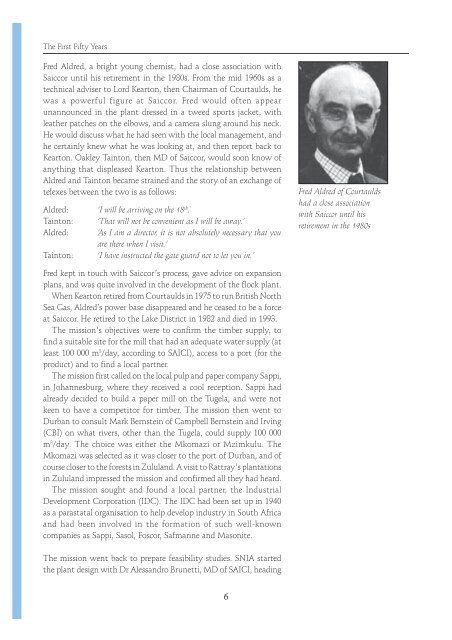Create successful ePaper yourself
Turn your PDF publications into a flip-book with our unique Google optimized e-Paper software.
<strong>The</strong> <strong>First</strong> Fifty <strong>Years</strong><br />
Fred Aldred, a bright young chemist, had a close association with<br />
<strong>Saiccor</strong> until his retirement in the 1980s� From the mid 1960s as a<br />
technical adviser to Lord Kearton, then Chairman of Courtaulds, he<br />
was a powerful figure at <strong>Saiccor</strong>� Fred would often appear<br />
unannounced in the plant dressed in a tweed sports jacket, with<br />
leather patches on the elbows, and a camera slung around his neck�<br />
He would discuss what he had seen with the local management, and<br />
he certainly knew what he was looking at, and then report back to<br />
Kearton� Oakley Tainton, then MD of <strong>Saiccor</strong>, would soon know of<br />
anything that displeased Kearton� Thus the relationship between<br />
Aldred and Tainton became strained and the story of an exchange of<br />
telexes between the two is as follows:<br />
Aldred: ‘I will be arriving on the 18 th � ’<br />
Tainton: ‘That will not be convenient as I will be away�’<br />
Aldred: ‘As I am a director, it is not absolutely necessary that you<br />
are there when I visit�’<br />
Tainton: ‘I have instructed the gate guard not to let you in�’<br />
Fred kept in touch with <strong>Saiccor</strong>’s process, gave advice on expansion<br />
plans, and was quite involved in the development of the flock plant�<br />
When Kearton retired from Courtaulds in 1975 to run British North<br />
Sea Gas, Aldred’s power base disappeared and he ceased to be a force<br />
at <strong>Saiccor</strong>� He retired to the Lake District in 1982 and died in 1993�<br />
<strong>The</strong> mission’s objectives were to confirm the timber supply, to<br />
find a suitable site for the mill that had an adequate water supply (at<br />
least 100 000 m 3 /day, according to SAICI), access to a port (for the<br />
product) and to find a local partner�<br />
<strong>The</strong> mission first called on the local pulp and paper company <strong>Sappi</strong>,<br />
in Johannesburg, where they received a cool reception� <strong>Sappi</strong> had<br />
already decided to build a paper mill on the Tugela, and were not<br />
keen to have a competitor for timber� <strong>The</strong> mission then went to<br />
Durban to consult Mark Bernstein of Campbell Bernstein and Irving<br />
(CBI) on what rivers, other than the Tugela, could supply 100 000<br />
m 3 /day� <strong>The</strong> choice was either the Mkomazi or Mzimkulu� <strong>The</strong><br />
Mkomazi was selected as it was closer to the port of Durban, and of<br />
course closer to the forests in Zululand� A visit to Rattray’s plantations<br />
in Zululand impressed the mission and confirmed all they had heard�<br />
<strong>The</strong> mission sought and found a local partner, the Industrial<br />
Development Corporation (IDC)� <strong>The</strong> IDC had been set up in 1940<br />
as a parastatal organisation to help develop industry in South Africa<br />
and had been involved in the formation of such well-known<br />
companies as <strong>Sappi</strong>, Sasol, Foscor, Safmarine and Masonite�<br />
<strong>The</strong> mission went back to prepare feasibility studies� SNIA started<br />
the plant design with Dr Alessandro Brunetti, MD of SAICI, heading<br />
6<br />
Fred Aldred of Courtaulds<br />
had a close association<br />
with <strong>Saiccor</strong> until his<br />
retirement in the 1980s

















